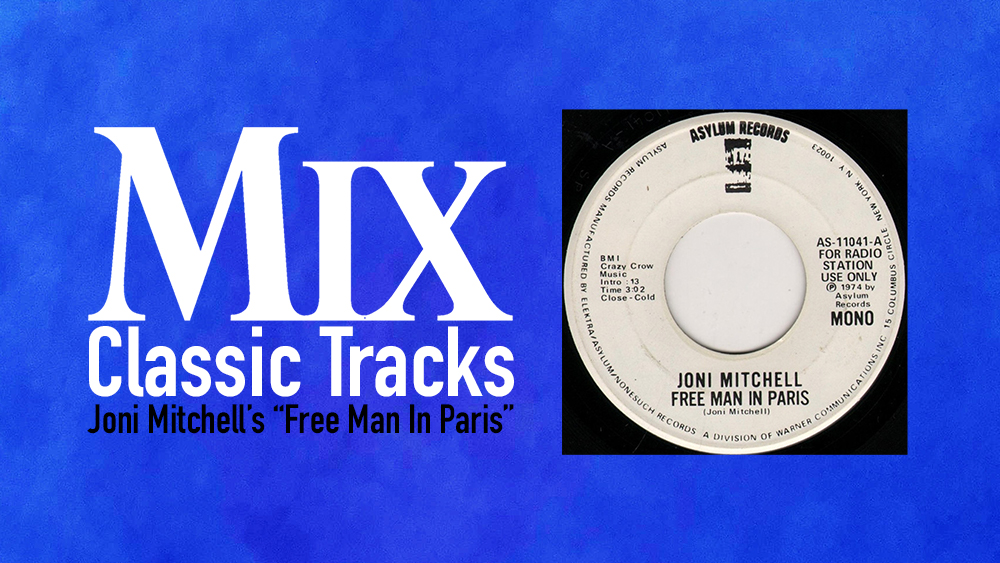
Ellis Sorkin had never intended on becoming an audio engineer, but luckily his father, who wrote the insurance for A&M Studios, envisioned it. He had taken his 14-year-old son on a tour of the studios and witnessed the impression that an Andy Williams/Claudine Longet recording session made on his son. Unbeknownst to the teenager, his father placed him on the long waiting list for the studio’s apprenticeship program.
Four years later, in 1973, a then 18-year-old Sorkin picked up a call from Larry Levine, chief engineer at A&M, asking if he would like to come in for an interview. Sorkin, who had just graduated high school, asked, “For what?”
He was hired and rose fast, from cleaning up and wrapping cables to assisting on demos within two months. He learned the studio equipment—HAECO consoles in all the rooms at the time—and he quickly became an in-demand assistant to such A&M greats as Hank Cicalo, Dick Bogert and Ray Gerhardt, along with independents such as Al Schmitt, Phil Ramone and Bill Schnee. Cicalo, he says, was the most technical of them all, and when engineer Henty Lewy became aware of how well Sorkin worked with him on sessions, he wanted Sorkin’s assistance as well.
The next thing Sorkin knew, he was sitting beside Lewy, assisting the engineer midway into Joni Mitchell’s legendary album Court and Spark, working on the hit “Free Man in Paris.”
THAT JONI VOCAL…
Mitchell was a night owl. Sessions were called for 7:00 or 8:00 p.m. and she might show up then, but according to Sorkin, she mostly arrived around 9:00 or 10:00, and once in a while, 11:00. And Mitchell was a chain smoker.
“When one was going out, another was being lit by that one,” Sorkin recalls. “I don’t remember anybody I worked with who smoked as much as she did. My clothes, my hair, everything reeked!”
Mitchell rarely sang with the band (unlike Joan Baez, whose Diamonds and Rust Sorkin engineered and says was tracked entirely live). “Once in a while, Joni sang a scratch vocal with the band, but not all the time by any means,” Sorkin says, adding that she would have used a Neumann U 87 mic at that time, but later switched to a Shure SM 7 because she wanted to be in the control room for some vocals. “She never would have done a live vocal completely that would have been a keeper. Never. Every vocal was almost to the degree of Karen Carpenter—maybe even more— where everything was surgically looked at. I remember punching in breaths with Karen, where I don’t remember that so much with Joni, but it was takes or parts of takes that would get comped together.”
The utter clarity of the vocal on “Free Man in Paris” is astounding. Aside from Mitchell’s own God-given gift, Sorkin attributes some of it to the Scully 16-track, 2-inch tape machines, saying, “Those machines were just wonderful. Nothing sounded like that.”
…AND THE AMAZING MUSICIANS
Mitchell was not as meticulous about her guitar playing as she was about her vocals, Sorkin notes, so sometimes she would play live with the other musicians. Although he can’t recall definitively whether she did so on “Free Man in Paris,” if she did, she would have been playing acoustic along with Larry Carlton on electric guitar, creating the song’s notable audio blend. Jose Feliciano on acoustic guitar was overdubbed later, along with additional guitar layers and doubling.
Having a drummer like John Guerin always ensured a great track, Sorkin says, adding that the mics on the cymbal overheads were either Neumann KM 84s with pads or AKG 414s with pads. The upper tom mics were Shure SM 57s, while the floor tom was captured with a Sony C38, and he miked the kick with an Electro-Voice RE 20. A KM 84 sat under the snare with a 10 dB pad, phase-reversed with an SM 57 on the top.
“SM 57s were frequently used because they had great isolation from other drums,” Sorkin asserts. “You could really zone in on getting a sound on ‘X’ drum. There was no compression, no gating, none of that kind of crap.”
The overdubs, Sorkin says, would have occurred in studios C, A or D. Mitchell liked the intimacy of studio C, and Sorkin believes they overdubbed Graham Nash and David Crosby’s background vocals in studio A or D. Fifty years later, Sorkin’s memory is hazy, but he says it is likely that Nash and Crosby sang together, although it’s possible that they tracked the two separately. “Joni wanted to have the control,” he reveals, “but most of the time, her exercising control over everything was on her own stuff.”
PRODUCING THE SOUND
Mitchell oversaw the sound even more so than Lewy, Sorkin says, but on a production level, not a technical level. “She would never say, ‘I don’t like the sound of that mic on me,’ or ‘Could we try less compression?’ But she would say, ‘Let’s do that again,’ ‘Let’s punch-in this,’ ‘Let’s run a bunch of these and then we’ll comp a vocal.’ All the time.” Lewy was not as technical as some of the other engineers on the lot, Sorkin says, so as Lewy’s assistant, he was very hands-on.
The mix on Court and Spark was executed largely by Lewy and Mitchell, with Sorkin moving in and out, assisting as needed. He remembers Mitchell being so brilliant that it could be intimidating.
“If I was alone with her in a room for 20 or 30 minutes, I’d be gone about 10 minutes into the conversation,” Sorkin says, laughing. “I mean, I’m not an idiot, but I would just get lost. She’s brilliant, off the charts.”
“Free Man in Paris” reached Number 22 on Billboard’s Hot 100 in the summer of 1974, and at age 80, Mitchell is enjoying a re-emergence, while Sorkin helms Studio Referral Service, a tool to help labels and management companies find the right studios for their artists.
“When I hear ‘Free Man in Paris,’ or, for that matter, many of the songs that I worked on with Joni, I get a warm and comfortable feeling,” Sorkin sums up, a bit of nostalgia in his voice. “It’s like they are embedded in me, perhaps because it was such an important part of my early life. I think back to working on the background vocals with Crosby and Nash hanging in the control room with Joni, Henry and myself. I remember feeling like, ‘Is this really happening?’ Surrounded by these legends and working with them was surreal for sure. Of course, the music was, as well. I was truly blessed to be in the presence of such musical royalty.”







